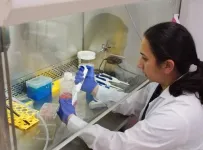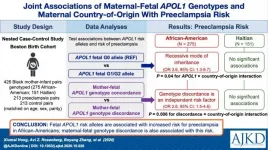Killing cancer by unleashing the body's own immune system
University of Missouri scientists demonstrate a new bacteria-based strategy for turning the body's own immune system against cancer
2021-01-12
(Press-News.org) The body's immune system is the first line of defense against infections like bacteria, viruses or cancers. Some cancers, however, have developed the art of molecular deception to avoid destruction by the body's immune system. However, a University of Missouri researcher might have found a new way to help the body's immune system get past that deception and destroy the cancer.
"Normally, your body's immune cells are constantly on patrol to identify and destroy foreign entities in the body," said Yves Chabu, an assistant professor in the Division of Biological Sciences. "Normal cells put up a 'don't-eat-me' molecular flag that is recognized by immune cells, thereby preventing destruction of normal tissues. But some cancers have also developed the ability to mimic normal cells and produce this 'don't eat me' signal. As a consequence, the immune system fails to recognize the cancer as a defective tissue and leaves it alone, which is bad news for the patient."
Immunotherapies are cancer drugs that essentially block the "don't-eat-me" signal coming from the cancer and allow the immune system to kill it. Chabu, whose appointment is in the College of Arts and Science, said while these immunotherapies work for certain types of cancers, prostate cancer is highly immunosuppressive, meaning the cancer's physical and molecular environments simply overpower the body's immune system. But Chabu might have unlocked a solution with help from a more than 50-year-old strain of bacteria.
"Cancers are different in one individual to the next, even when they affect the same tissue," Chabu said. "These interpersonal differences contribute to whether or not a particular therapy will effectively kill the cancer and help the patient. The bacteria itself is genetically pliable, therefore it can be genetically modified to overcome patient-specific therapeutic limits. Imagine a patient whose cancer isn't responding to traditional therapies and has no other treatment options. One can envision genetically modifying the bacteria such that it can unload therapeutics that specifically exploit that cancer's unique vulnerabilities and kill it."
In a previous study, scientists at the Cancer Research Center and the University of Missouri developed a genetically distinct and non-toxic strain of salmonella called CRC2631 to select and kill cancer cells. CRC2631 was derived from another strain of salmonella that had been stored at room temperature for more than half a century. Now, scientists like Chabu are demonstrating the ability for CRC2631, which enthusiastically targets cancerous tumors, to be used to unleash the body's immune system against prostate cancer.
"Because CRC2631 preferentially colonizes tumor cells, the effect is mainly localized to the tumor," Chabu said. "The use of CRC2631 to design and deliver patient-tailored therapeutics foretells potential in precision medicine, or the ability to tailor a treatment to a specific patient."
Highlighting the promise of personalized health care and the impact of large-scale interdisciplinary collaboration, the University of Missouri System's NextGen Precision Health initiative is bringing together innovators from across the system's four research universities in pursuit of life-changing precision health advancements. It's a collaborative effort to leverage the strengths of Mizzou and entire UM System toward a better future for Missouri's health. An important part of the initiative is the construction of the new NextGen Precision Health building, which will expand collaboration between researchers, clinicians and industry leaders in a state-of-the-art research facility.
INFORMATION:
"Evaluations of CRC2631 toxicity, tumor colonization, and genetic stability in the TRAMP prostate cancer model," was published in Oncotarget. Funding was provided by the Cancer Research Center.
[Attachments] See images for this press release:

ELSE PRESS RELEASES FROM THIS DATE:
2021-01-12
Acknowledging that COVID-19 may be here to stay, Oregon Health & Science University has laid out a series of steps to prepare patients for elective surgery following their illness.
The evaluation, outlined in a commentary published in the journal Perioperative Medicine, is believed to be the first published protocol laying out a COVID-era path forward in American medicine.
"We think this is groundbreaking," said senior author Avital O'Glasser, M.D., associate professor of medicine (hospital medicine) in the OHSU School of Medicine. "We are hoping other clinics and surgical centers can use this to keep their patients safe."
The work started around Memorial Day, when OHSU clinicians began to see an increasing number of patients ...
2021-01-12
Fetal APOL1 kidney risk alleles are associated with increased risk for preeclampsia in African Americans and maternal fetal genotype discordance is also associated with this risk.
Preeclampsia, characterized by increased blood pressure after 20 weeks of pregnancy, as well as other abnormalities (e.g., protein in the urine), is dangerous to mothers and their infants. Previous studies found that individuals with African ancestry may carry APOL1 genetic variants that increase risk for chronic kidney disease. This study published in the American Journal of Kidney Diseases (AJKD) found that fetal high-risk APOL1 genotypes and maternal-fetal APOL1 genotype discordance independently contribute to preeclampsia risk in African-American mothers. This ...
2021-01-12
TROY, N.Y. -- An analysis of an exhaustive dataset on cells essential to the mammalian immune system shows that our ability to fight disease may rely more heavily on daily circadian cycles than previously assumed.
Malfunctions in circadian rhythms, the process that keeps our bodies in tune with the day/night cycles, are increasingly associated with diabetes, cancer, Alzheimer's, and many other diseases. An investigation published today in Genome Research shows that the activity of macrophages -- cells within us that seek and destroy intruders like bacteria -- may time daily changes in their responses to pathogens and stress through the circadian control of metabolism.
In this study, ...
2021-01-12
Organizations seeking to fill internal roles traditionally have two options: promote from within or hire externally. Internal promotions benefit from being vetted talent who possess firm-specific skills while outside hires harbor external knowledge that can infuse an organization with new energy. Though this dichotomy is often accepted as unavoidable, there is a third option: boomerang employees.
Boomerang employees are those who return to an organization after an amicable absence. Whether the absence was for personal or professional reasons, their return provides unique value to an ...
2021-01-12
A team of astronomers led by the University of Arizona has observed a luminous quasar 13.03 billion light-years from Earth - the most distant quasar discovered to date. Dating back to 670 million years after the Big Bang, when the universe was only 5% its current age, the quasar hosts a supermassive black hole equivalent to the combined mass of 1.6 billion suns.
In addition to being the most distant - and by extension, earliest - quasar known, the object is the first of its kind to show evidence of an outflowing wind of super-heated gas escaping from the surroundings of the black hole at a fifth of the speed of light. In ...
2021-01-12
An international team of astronomers has discovered the most distant quasar yet found -- a cosmic monster more than 13 billion light-years from Earth powered by a supermassive black hole more than 1.6 billion times more massive than the Sun and more than 1,000 times brighter than our entire Milky Way Galaxy.
The quasar, called J0313-1806, is seen as it was when the Universe was only 670 million years old and is providing astronomers with valuable insight on how massive galaxies -- and the supermassive black holes at their cores -- formed in the early Universe. The scientists presented their findings to the American Astronomical Society's meeting, now underway virtually, and in a paper accepted to ...
2021-01-12
Maunakea, Hawaii - The most distant quasar known has been discovered. The quasar, seen just 670 million years after the Big Bang, is 1000 times more luminous than the Milky Way, and is powered by the earliest known supermassive black hole, which weighs in at more than 1.6 billion times the mass of the Sun. Seen more than 13 billion years ago, this fully formed distant quasar is also the earliest yet discovered, providing astronomers with insight into the formation of massive galaxies in the early universe. The result was released today at the January 2021 meeting of the American Astronomical Society (AAS).
Quasars, which are powered by the feeding frenzies of colossal supermassive black holes, are the most energetic objects ...
2021-01-12
The American Society of Hematology (ASH), the International Society on Thrombosis and Haemostasis (ISTH), National Hemophilia Foundation (NHF), and World Federation of Hemophilia (WFH) have developed joint clinical practice guidelines on the diagnosis and management of von Willebrand Disease (VWD), the world's most common inherited bleeding disorder. The guidelines were published today in Blood Advances.
VWD affects approximately 1% of the world's population, and it is the most common bleeding disorder. Although VWD occurs among men and women equally, women are more likely to notice the symptoms because of heavy or abnormal bleeding during their menstrual periods and after childbirth. This inherited condition results in the ...
2021-01-12
LA JOLLA, CALIF. - Jan 12, 2020 - Scientists at Sanford Burnham Prebys Medical Discovery Institute have identified the sensor in human lungs that detects SARS-CoV-2 and signals that it's time to mount an antiviral response. The study, published today in Cell Reports, provides insights into the molecular basis of severe disease and may enable new strategies for the treatment and prevention of COVID-19.
"Our research has shown that MDA-5 is the immune cop that's tasked to keep an eye out for SARS-CoV-2 and call for back-up," says Sumit Chanda, Ph.D., director of the Immunity and Pathogenesis Program at Sanford Burnham Prebys and senior author of the study. ...
2021-01-12
Key Takeaways:
Machine learning can be an effective tool to set competitive prices.
Artificial intelligence has its limits on how to set the most effective prices due to variables beyond the seller's control.
Over the long term, supracompetitive pricing can result.
CATONSVILLE, MD, January 12, 2021 - Machine learning and artificial intelligence (AI) are perfectly suited to help companies and marketers monitor and set prices based on real-time dynamic pricing. But new research has identified some possible unintended consequences of AI in this area.
Machine learning algorithms don't always account for factors outside of the seller's control, such as competitor prices. Researchers ...
LAST 30 PRESS RELEASES:
[Press-News.org] Killing cancer by unleashing the body's own immune system
University of Missouri scientists demonstrate a new bacteria-based strategy for turning the body's own immune system against cancer





